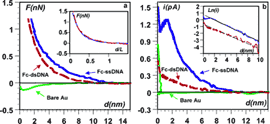Publication
616
J. Phys. Chem. B , 111, 6051-6058, 2007.
DOI:
10.1021/jp070432x
|
|
|
|
|
|
 |
Exploring the Motional Dynamics of End-Grafted DNA Oligonucleotides by in Situ Electrochemical Atomic Force Microscopy |
|
|
|
|
|
|
|
Kang Wang, Cédric Goyer, Agnès Anne and Christophe Demaille
Laboratoire d'Electrochimie Moléculaire, Unité Mixte de Recherche Université, CNRS No 7591, Université de Paris 7-Denis Diderot, 2 place Jussieu, 75251 Paris Cedex 05, France
We introduce herein the use of atomic-force electrochemical microscopy (AFM-SECM) to simultaneously
probe locally the conformation and motional dynamics of nanometer-sized single-stranded (ss) and double-stranded (ds) DNA oligonucleotides end-tethered to electrode surfaces. The ss-DNA system studied here
consists of a low-density monolayer of (dT)20 oligonucleotides, 5'-thiol end-tethered onto a flat gold surface
via a C6 alkyl linker and bearing at their free 3'-end a redox ferrocene label. It is shown that, as a result of
the flexibility of the relatively long C6 linker, hinge motion, rather than elastic deformation of the DNA
chain, is the major component of the dynamics of both the (dT)20 strand and its post-hybridized (dT-dA)20
duplex. DNA chain elasticity is nevertheless sufficiently contributing to the overall dynamics to result in ~4
times slower dynamics for (dT-dA)20 than for (dT)20. Taking advantage of this dissimilar dynamical behavior
of ss- and ds-DNA, it is demonstrated that hybridization can be easily locally detected at the scale of ~200
molecules by AFM-SECM. |

